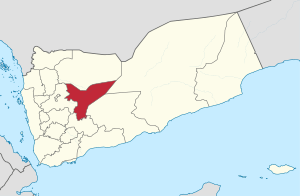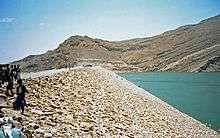Ma'rib Governorate
| Ma’rib مَـأرِب | |
|---|---|
| Governorate | |
 | |
| Country | Yemen |
| Seat | Ma'rib |
| Area | |
| • Total | 20,023 km2 (7,731 sq mi) |
| Population (2011)[1] | |
| • Total | 288,000 |
| • Density | 14/km2 (37/sq mi) |
| Website |
www |
Ma'rib (Arabic: مَـأْرِب Maʾrib) is a governorate of Yemen. It is located 173 kilometers to the northeast of Yemen's capital, Sana'a. The population of Ma'rib Governorate comprises 1.2% of the country's total population. The city of Ma'rib is the capital of the governorate, and was established after the discovery of oil deposits in 1984.[2]
Ma'rib Governorate borders Al Jawf Governorate to the north, Al Bayda Governorate to the south, Shabwah Governorate to the southeast, Hadhramaut Governorate to the east, and Sana'a Governorate to the west. Ma'rib Governorate's area is approximately 17,405 square kilometres (6,720 square miles), divided among 14 districts. Ma'rib District is the biggest district by area. Ma'rib's population in 2004 was 241,619.
Climate
The governorate's climate varies based on elevation. The mountainous and elevated regions, which make up the western half of the governorate, are dominated by a moderate climate with hot summers and relatively cold winters. In the low-lying and plain regions, the climate is hot in the summers and moderate in the winters. The desert regions are characterized by a dry climate: hot in the summers, and cold and dry in the winters.
Summer rains fall on most parts of the governorate, but the amount of rainfall is usually small, especially in the eastern parts. Most parts of Ma'rib Governorate suffer from drought, given the sparse rainfall.
Agriculture and economy
In the 1980s, after the region was hit by floods, a dam was constructed in Ma'rib, which would later be deemed to be important for the country's agriculture and economy.[3][4][5] Its construction was financed by Sheikh Zayed bin Sultan Al Nahyan of the United Arab Emirates, who himself was reportedly a descendant of people from this area.[6]
The area is home to the largest gas-fired power plant in Yemen, the Ma'rib Gas Plant, whose electricity towers have been sabotaged continuously since the beginning of 2011. These sabotage operations did not stop until 2014, due to the inability of the Basindawa government to deter the saboteurs.
Agriculture is the main livelihood for the governorate's residents. Ma'rib Governorate ranks third in Yemen behind Al Hudaydah Governorate and Sana'a Governorate in terms of agricultural production, making up 7.6% of the country's total agricultural production. Its most important agricultural products are fruits, grains, and vegetables. Many types of livestock are found in the governorate, including cattle, camels, sheep, goats, donkeys, and poultry. There are also quite a number of beehives. According to statistics for the time period 2007-11, the governorate was home to approximately 1,943,564 sheep, approximately 1,669,370 goats, roughly 42,000 cattle, and about 112,782 camels, which make up 3.80% of Yemen's total livestock.
Flora and fauna
Vegetation in the governorate is diverse, despite its sparseness and lack of density in terms of quantity and quality from place to place, depending on the nature of the surface and prevailing climate. The most important trees are the Christ's thorn jujube, qard tree, buckthorn, acacia (particularly or including the umbrella thorn acacia, as well as other thorny trees. There are also many types of grasses and small plants that grow in the rainy seasons.
Many types of wild animals are present in the governorate, and are plentiful in the western areas, including hyenas, snakes, wild rabbits, hedgehogs, and hyraxes. Birds include falcons, pigeons, eagles, and owls. The birds are numerous in areas dense with trees, as well as near wadis, especially those with water. The presence of the nimr (Arabic: نِـمْـر, leopard) was reported in the Sarawat Mountains.[7][8]
Population
The total number of residents living in the governorate was 238,522 according to the 2004 census, and the rate of growth was 2.72%. According to 2009 projections, the population grew to approximately 271,855.
Districts
See also
References
- ↑ "Statistical Yearbook 2011". Central Statistical Organisation. Retrieved 24 February 2013.
- ↑ United States Army Training and Doctrine Command (February 2010). "Yemen Smart Book" (PDF). Cryptocomb. p. 179. Retrieved 27 May 2012.
- ↑ WAM (2013-07-29). "Key aid projects during Zayed's time". Khaleej Times. Retrieved 2018-04-09.
- ↑ Al-Qalisi, M.; Vela, J. (2015-09-30). "The dam that Sheikh Zayed built". The National. Retrieved 2018-04-09.
- ↑ Salama, S. (2015-12-01). "UAE playing a historic role in Yemen". Gulf News. Retrieved 2018-04-09.
- ↑ Robert D. Burrowes (2010). Historical Dictionary of Yemen. Rowman & Littlefield. pp. 234–319. ISBN 0810855283.
- ↑ Judas, J.; Paillat, P.; Khoja, A.; Boug, A. (2006). "Status of the Arabian leopard in Saudi Arabia" (PDF). Cat News. Special Issue 1: 11–19.
- ↑ Spalton, J. A. & Al-Hikmani, H. M. (2006). "The Leopard in the Arabian Peninsula – Distribution and Subspecies Status" (PDF). Cat News (Special Issue 1): 4–8.
